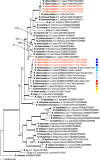Anther smuts of Silene acaulis and S. uniflora in the Outer Hebrides, including an assessment of ITS genotypes of Microbotryum silenes-acaulis
- PMID: 28824843
- PMCID: PMC5493529
- DOI: 10.5598/imafungus.2017.08.01.08
Anther smuts of Silene acaulis and S. uniflora in the Outer Hebrides, including an assessment of ITS genotypes of Microbotryum silenes-acaulis
Abstract
Anther smuts on Silene acaulis and S. uniflora from the Outer Hebrides, Scotland, UK), are analysed using morphological and molecular techniques, and found to represent Microbotryum silenes-acaulis and M. silenes-inflatae, respectively. This is the first identification of caryophyllaceous anther smuts in the Outer Hebrides according to modern species concepts and the first report of Microbotryum silenes-acaulis confirmed by molecular analysis from the British Isles. Additionally, the genetic structure of Microbotryum silenes-acaulis, based on all currently available ITS sequences, is analysed and discussed. Seven ITS genotypes are determined for Microbotryum silenes-acaulis, including three genotypes in North America and four genotypes in Europe. Compared to European accessions, all North American accessions share specific nucleotides and are genetically divergent.
Keywords: Basidiomycota; Microbotryum; Ustilaginales; arctic and alpine fungi; genotypes; molecular phylogenetics; plant pathogens.
Figures







References
-
- Abbate JL, Antonovics J. (2014) Elevational disease distribution in a natural plant–pathogen system: insights from changes across host populations and climate. Oikos 123: 1126–1136.
-
- Angus S. (1997) The Outer Hebrides: the shaping of the islands. Cambridge: White Horse Press.
-
- Bueker B, Eberlein C, Gladieux P, Schaefer A, Snirc A, et al. (2016) Distribution and population structure of the anther smut fungus Microbotryum silenes-acaulis parasitizing an arctic-alpine plant. Molecular Ecology 25: 811–824. - PubMed
-
- Campbell ME. (1936) The natural history of Barra, Outer Hebrides: fungi. Proceedings of the Royal Physical Society of Edinburgh 22: 259–260.
-
- Chlebicki A, Suková M. (2005) Two Microbotryum species from the Himalayas. Mycotaxon 93: 149–154.
LinkOut - more resources
Full Text Sources
Other Literature Sources
Molecular Biology Databases
